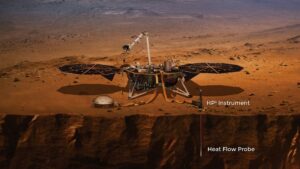
March 7, 2022
The physical properties of space and extraterrestrial bodies such as planets have long been seen as a mysterious and complex topic that has piqued the interest of scientists and curious minds for centuries. Despite there being no shortage of hypotheses and theories attempting to explain how planets came to be as we see them today, it wasn’t until recently that we have been able to develop and deploy technology advanced enough to be able to paint a better picture of how these foreign structures were formed.
Copious amounts of research and computer modeling are currently underway at NASA and similar space agencies around the world to explore and analyze the environment on Mars. Mars is the fourth planet from the sun and is known for its dusty, cold, dessert like surface that is a result of its extremely thin atmosphere.
Mars is also a very dynamic planet with ice caps, seasons, canyons, and extinct volcanic structures. The earth is roughly twice the diameter of Mars and is characterized by its life supporting features including vast amounts of surface water and a ‘stable’ environmental temperature. Despite their differences, Mars is more similar to earth than any other planet in the solar system.
Both planets contain many of the same geographical features including a landscape littered with mountains, valleys, glaciers, and ice caps, besides from being deemed as uninhabitable, the environment on Mars doesn’t differ much from the one we encounter on earth every day.
The Martian day is only slightly longer than the one we experience on earth at roughly 24 hours and 39 minutes and many scientists even consider that the dry environment that is now present on Mars was once one that contained enough water to support life.

Figure 1: Surface images of Mars captured by NASA.
To test their numerous hypotheses regarding the nature of the Martian landscape, researchers and engineers at NASA have developed rovers and landers to scan its surface and report back on their findings to hubs all over the world. One of the most recent advances in this area was the deployment of the Insight Lander which touched down on the surface of the red planet in November 2018. This lander was the first of its kind to go beyond surface level analysis and look at the details of the planet’s interior.
Insight is a part of NASA’s Discovery Program which is managed by the agency’s Marshall Space Flight Center located in Huntsville, Alabama. Several European parties, including France’s Centre National d’Etudes Spatiales (CNES) and the German Aerospace Center (DLR) are supporting this mission. DLR provided the heat flow and physical properties package (HP3) that has made key findings in terms of measuring the thermal conductivity of Mars.

Figure 2 : Artist’s concept of the insight lander on Mars – featuring the HP3 and Heat Flow Probe.
HP3 is a unique and advanced extension of the Insight Lander that will allow scientists to take a reading of the planet’s temperature for the first time by measuring how heat flows through the planet and drives its geological processes. Built and operated by DLR, HP3 will deploy a probe known as the mole into the ground.
This probe is equipped with a self-hammering spike that allows it to bury itself up to 16 feet (5 meters) below the surface. This is deeper than any previous instrument deployed on the red planet has been able to go. The mole will drag a tether behind it that is embedded with a number of temperature sensors used to measure the internal heat of the planet.
In addition, to burrowing, the mole will give off heat pulses which will allow scientists to determine how quickly the mole warms the surrounding rock and calculate the thermal conductivity of that material. If the material is a good conductor of heat, the pulse will decay quickly, whereas if it is a poor conductor, the pulse will decay slowly.
By definition, a material’s thermal conductivity is a measure of the degree to which heat passes through a given material. A higher thermal conductivity value indicates efficient heat transferring abilities and is a well-known property of many rocks that litter the surface of planets throughout the solar system.
As the mole continues to bury itself deeper into the soil, it stops every 50cm to take a temperature reading of its surroundings. Due to the actual process of hammering generating friction and heat, the mole will first have to go through a period of dormancy (roughly 3 days) to cool off before it is able to take accurate temperature and thermal conductivity readings of the surrounding soil.
The probe will then be heated up by roughly 18 degrees Fahrenheit over a 24-hour period. The rate at which this happens will allow scientists to determine the thermal conductivity of the soil. The mole itself weighs less than a pair of shoes and uses less power than a standard Wi-Fi router.
The accuracy and precision that went into the design of this piece of equipment is a result of years of work completed by a team of the world’s most elite physicists and thermal engineers. Many of the individuals who worked on the project stated that it took a fair deal of trial and error before they were able to design a mole that was able to dig 16 feet into the ground without shattering itself, however, the version they sent to Mars has proven its robustness time and time again.
Insight will be the first mission to peer into Mar’s interior and measure how heat is conducted to the surface. A substantial portion of this energy is what was left over from when the planet formed roughly 4 billion years ago and preserves a record of its creation. Scientists emphasize that most of the geology on the planet is a result of the movement of heat and energy through its interior.
Volcanic eruptions that are now known to have occurred frequently throughout the planet’s past were driven by this flow of heat pushing up rocky material and constructing the towering mountains that Mars is now famous for.
The movement of heat on Mars follows the same principles and rules of thermodynamics as what applies here on Earth. We can think of this process of planetary heat flow similar to what occurs when you boil a pot of water. As water heats up, it becomes less dense and will rise upwards forcing the cooler denser water towards the bottom of the pot.
This movement of heat through a medium is known as convection. This same process happens on a planet over millions of years, churning rocks on the surface and in the interior. Sporadically, large pockets of heat will build up within the interior of the planet causing the formation of volcanos.
This build-up of heat and gas is what is thought to be the cause of the formation of the large riverbeds that are scattered across the planet’s surface. The gas expelled from volcanoes also contained water vapor which cooled into a liquid and may have formed several channels surrounding the base of many volcanic structures.
The smaller a planet is, the faster it will lose heat. Since Mars is only 1/3 the size of earth, it is hypothesized that most of its volcanic activity occurred within the first billion years of formation.
The deployment of the Insight Lander and the HP3 extension will give scientists a closer look at the exact mechanisms occurring within the interior of Mars and enhance their ability to discover more about the inner workings of this earth like planet. With this information, they will be able to paint a clearer picture of the history of Mars and what makes it unique in its inability to sustain life in the same manner that its neighboring cousin earth can.
Author: Kallista Wilson | Junior Research Scientist | Thermtest
NASA’s InSight Has a Thermometer for Mars. NASA Jet Propulsion Laboratory (JPL). Retrieved December 19, 2021, from https://www.jpl.nasa.gov/news/nasas-insight-has-a-thermometer-for-mars
https://jpl.nasa.gov. (n.d.-b). NASA’s InSight Prepares to Take Mars’ Temperature. NASA Jet Propulsion Laboratory (JPL). Retrieved December 19, 2021, from https://www.jpl.nasa.gov/news/nasas-insight-prepares-to-take-mars-temperature
mars.nasa.gov. (n.d.-a). Heat Probe | Instruments. NASA’s InSight Mars Lander. Retrieved December 19, 2021, from https://mars.nasa.gov/insight/spacecraft/instruments/hp3
mars.nasa.gov. (n.d.-b). NASA’s InSight Reveals the Deep Interior of Mars. NASA’s InSight Mars Lander. Retrieved December 17, 2021, from https://mars.nasa.gov/news/8996/nasas-insight-reveals-the-deep-interior-of-mars?site=insight
Thermal Conductivity. (n.d.). Retrieved May 9, 2021, from http://hyperphysics.phy-astr.gsu.edu/hbase/Tables/thrcn.html